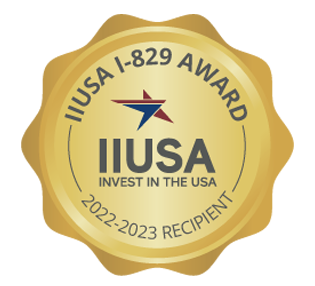Understanding How the EB-5 Reform and Integrity Act of 2022 (RIA) Revamped the EB-5 Program
The EB-5 program, also known as an Immigrant Investor Visa or Golden Visa, allows individuals to invest in the United States and obtain a green card through that investment. Since 1990, the program has helped investors and their families live and work in the United States.
In 2022, a new law, the EB-5 Reform and Integrity Act (the “RIA”) introduced significant changes to enhance investor protections, improve transparency, and create greater predictability. The RIA also established new visa categories and enabled in-country applicants to access interim immigration benefits more quickly.
Stricter Oversight of Regional Centers
Regional Centers, which handle approximately 90% of all EB-5 applications, must now meet stricter standards. These include mandatory audits by the United States Citizenship and Immigration Services (USCIS) every five years and annual reporting requirements.
Regional Centers are also required to disclose changes in management or structure, ensuring that operations remain transparent. Additionally, the RIA prohibits participation by individuals with a history of financial fraud, government officials, and certain non-residents.
The RIA also increased application fees for regional centers to nearly $50,000, with an annual contribution of $20,000 to the EB-5 Integrity Fund. This fund, used by USCIS to primarily administer the EB-5 Program, supports fraud detection and enforcement efforts.
RIA Created Predictable Investment Timelines
A key improvement is the RIA’s adjustment to the “sustainment period” — the time an investor’s funds must remain at risk. Previously, this period could not begin until a conditional green card was approved, often resulting in delays. Under current USCIS interpretation, the sustainment period starts as soon as the invested funds are disbursed to the job-creating entity. This change benefits all investors but is especially helpful for applicants from backlogged countries like Mainland China and India. By “decoupling” the sustainment period from the green card adjudication process, investors can recover their capital sooner, typically after the three-to-five-year loan term.
Read the article for detailed information about the EB-5 investment visa process and repayment timelines.
RIA Introduced Set-Aside Visa Categories
The RIA introduced reserved visa categories to address the high demand in the EB-5 program. With approximately 10,000 visas allocated annually, demand from countries like Mainland China and India frequently surpasses the per-country cap of 7.1%, resulting in significant backlogs. To mitigate these delays, the RIA created three specific reserved visa categories with defined allocations:
- 20% for rural areas: Projects located in areas with low population density.
- 10% for high-unemployment areas: Projects in regions with significantly higher unemployment rates than the national average.
- 2% for infrastructure projects: Large-scale infrastructure developments with government involvement.
These reserved categories prioritize visas for investors in qualifying projects, helping applicants from oversubscribed countries gain access to visas more quickly. Read more details about EB-5 visa set-asides and their benefits for investors in the article.
RIA Allows Concurrent Filing of Immigration Petitions and Adjustment of Status for U.S.-Based Investors
The RIA has also made the EB-5 program more accessible to individuals already living in the United States on temporary visas, such as H-1B work visas or F-1 student visas. As long as visas are available, these investors can now take advantage of concurrent filing, allowing them to apply for a green card while simultaneously adjusting their immigration status.
This simultaneous process provides interim benefits, including:
- Work authorization, freeing investors from reliance on employer sponsorship.
- Travel permission, allowing investors to leave and re-enter the United States without requiring a new visa.
- Increased flexibility in pursuing business or educational opportunities.
By reducing dependency on temporary work visas, the RIA offers a smoother path for investors already residing in the United States. Read more about the EB-5 concurrent filing process.
RIA Protects Against Future Rule Changes
Another major benefit introduced by the RIA is the “grandfathering” provision. This rule ensures that an investor’s application is processed under the laws in effect at the time of filing, regardless of any future changes to the EB-5 program. This provision provides stability and confidence for investors, knowing that their application will not be affected by potential program updates.
Additionally, in the event of a temporary lapse in the EB-5 program’s authorization, the RIA guarantees that ongoing applications will still be processed.
Why does the RIA Matter?
The EB-5 Reform and Integrity Act of 2022 represents a turning point for the EB-5 program. By addressing long-standing concerns, the RIA has made the program more transparent and efficient, instilling confidence in investors. With better protections and a clearer process, the EB-5 program continues to serve as a reliable and straightforward pathway for families seeking to make the United States their home.
For investors, these changes not only enhance the EB-5 program’s safety but also ensure that their journey toward U.S. residency is smooth and secure. Whether seeking new business opportunities, better education for their children, or a higher quality of life, the RIA ensures the EB-5 program remains a trusted option for achieving the American dream.
For a Free Consultation with an Experienced EB-5 Professional Enter your Details
Disclaimer
The opinions expressed in this video/blog post are solely those of the presenter/author. The information provided herein is for general informational purposes only and should not be considered as professional or legal advice. The presenter/author or Golden Gate Global do not endorse or take responsibility for any actions taken based on the information presented herein. Viewers/readers are advised to seek appropriate professional advice before making any decisions or taking any actions based on the content of this video/blog post.



